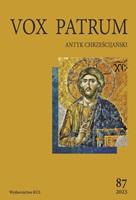Palący oddechem wąż („serpens flatu adurens”) św. Hieronima
St. Jerome’s “Serpent Burning with its Breath” (“serpens flatu adurens”)
Author(s): Krzysztof MortaSubject(s): Biblical studies, Systematic Theology, Sociology of Religion, History of Religion
Published by: Katolicki Uniwersytet Lubelski Jana Pawła II - Wydział Teologii
Keywords: St. Jerome; Symmachus; snake; serpent; basilisk; prester; biblical translation studies;
Summary/Abstract: The article is about a mention of “serpens flatu adurens” – “a serpent burning with its breath” (Deut 8:14) found in St. Jerome’s translation of the Old Testament. The snake is listed among other venomous animals that threatened the Israelites during their journey through the desert. The article intends to answer – basing on the ancient histori-city and literature – what kind of actual snake is behind this extraordinary description. In his translation St. Jerome mentions different snake species known in the Graeco-Roman world, as equivalents to their Hebrew names. As is turns out, Jerome took the discussed in the article term from Symmachus. And Symmachus, in turn, drew on rabbinic commen-tary and made a mistake of mistranslating the Hebrew text. The mistake was, however, acceptable for Jerome in relation to the basilisk. In the ancients’ belief this serpent – along with its deadly abilities – had a power of burning everything around. St. Jerome introdu-ced the name of the basilisk to the Bible seven times (in Septuagint the snake appears only twice). The discussed case would be the 8th mention of the basilisk in Jerome’s translation of the Bible.
Journal: Vox Patrum
- Issue Year: 2023
- Issue No: 87
- Page Range: 295-312
- Page Count: 18
- Language: Polish

